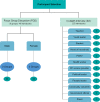Perceptions of family planning services and its key barriers among adolescents and young people in Eastern Nepal: A qualitative study
- PMID: 34038439
- PMCID: PMC8153486
- DOI: 10.1371/journal.pone.0252184
Perceptions of family planning services and its key barriers among adolescents and young people in Eastern Nepal: A qualitative study
Abstract
Introduction: Family planning methods are used to promote safer sexual practices, reduce unintended pregnancies and unsafe abortion, and control population. Young people aged 15-24 years belong to a key reproductive age group. However, little is known about their engagement with the family planning services in Nepal. Our study aimed to identify the perceptions of and barriers to the use of family planning among youth in Nepal.
Methods: A qualitative explorative study was done among adolescents and young people aged 15-24 years from the Hattimuda village in eastern Nepal. Six focus group discussions and 25 in-depth interviews were conducted with both male and female participants in the community using a maximum variation sampling method. Data were analyzed using a thematic framework approach.
Results: Many individuals were aware that family planning measures postpone pregnancy. However, some young participants were not fully aware of the available family planning services. Some married couples who preferred 'birth spacing' received negative judgments from their family members for not starting a family. The perceived barriers to the use of family planning included lack of knowledge about family planning use, fear of side effects of modern family planning methods, lack of access/affordability due to familial and religious beliefs/myths/misconceptions. On an individual level, some couples' timid nature also negatively influenced the uptake of family planning measures.
Conclusion: Women predominantly take the responsibility for using family planning measures in male-dominated decision-making societies. Moreover, young men feel that the current family planning programs have very little space for men to engage even if they were willing to participate. Communication in the community and in between the couples seem to be influenced by the presence of strong societal and cultural norms and practices. These practices seem to affect family planning related teaching at schools as well. This research shows that both young men and women are keen on getting involved with initiatives and campaigns for supporting local governments in strengthening the family planning programs in Nepal.
Conflict of interest statement
The authors have declared that no competing interests exist.
Similar articles
-
Side-Effects and Social Norms Influencing Family Planning Use in Nepal.Kathmandu Univ Med J (KUMJ). 2017 Jul-Sept.;15(59):222-229. Kathmandu Univ Med J (KUMJ). 2017. PMID: 30353897
-
Beyond knowledge acquisition: factors influencing family planning utilization among women in conservative communities in Rural Burundi.Reprod Health. 2021 May 13;18(1):94. doi: 10.1186/s12978-021-01150-7. Reprod Health. 2021. PMID: 33985538 Free PMC article.
-
Behavioral barriers to the use of modern methods of contraception among unmarried youth and adolescents in eastern Senegal: a qualitative study.BMC Public Health. 2020 Jun 29;20(1):1025. doi: 10.1186/s12889-020-09131-4. BMC Public Health. 2020. PMID: 32600290 Free PMC article.
-
Contraception in The Netherlands: the low abortion rate explained.Patient Educ Couns. 1994 Jul;23(3):161-71. doi: 10.1016/0738-3991(94)90032-9. Patient Educ Couns. 1994. PMID: 7971545 Review.
-
Dirty and 40 days in the wilderness: Eliciting childbirth and postnatal cultural practices and beliefs in Nepal.BMC Pregnancy Childbirth. 2016 Jul 5;16(1):147. doi: 10.1186/s12884-016-0938-4. BMC Pregnancy Childbirth. 2016. PMID: 27381177 Free PMC article. Review.
Cited by
-
Barriers and enablers to the implementation of immediate postpartum and post-abortion family planning service integration in primary health care units of Wolaita Zone, Southern Ethiopia: A baseline study for implementation research.PLoS One. 2024 Jul 25;19(7):e0303809. doi: 10.1371/journal.pone.0303809. eCollection 2024. PLoS One. 2024. PMID: 39052648 Free PMC article.
-
Community perception of the determinants of unmet needs of family planning among married women in Buea Health District, Southwest Region, Cameroon.Pan Afr Med J. 2023 May 25;45:58. doi: 10.11604/pamj.2023.45.58.33949. eCollection 2023. Pan Afr Med J. 2023. PMID: 37637402 Free PMC article.
-
Exploring machine learning algorithms to predict not using modern family planning methods among reproductive age women in East Africa.BMC Health Serv Res. 2024 Dec 18;24(1):1595. doi: 10.1186/s12913-024-11932-x. BMC Health Serv Res. 2024. PMID: 39696425 Free PMC article.
-
Barriers in accessing family planning services in Nepal during the COVID-19 pandemic: A qualitative study.PLoS One. 2023 May 5;18(5):e0285248. doi: 10.1371/journal.pone.0285248. eCollection 2023. PLoS One. 2023. PMID: 37146025 Free PMC article.
-
Association of Male Partners' Gender-Equitable Attitudes and Behaviors with Young Mothers' Postpartum Family Planning and Maternal Health Outcomes in Kinshasa, DRC.Int J Environ Res Public Health. 2022 Sep 26;19(19):12182. doi: 10.3390/ijerph191912182. Int J Environ Res Public Health. 2022. PMID: 36231485 Free PMC article.
References
-
- Department of Health Services. Annual Report. DoHS. 2019. Available from: https://dohs.gov.np/wp-content/uploads/2019/07/DoHS-Annual-Report-FY-207...
MeSH terms
LinkOut - more resources
Full Text Sources
Other Literature Sources
Medical


